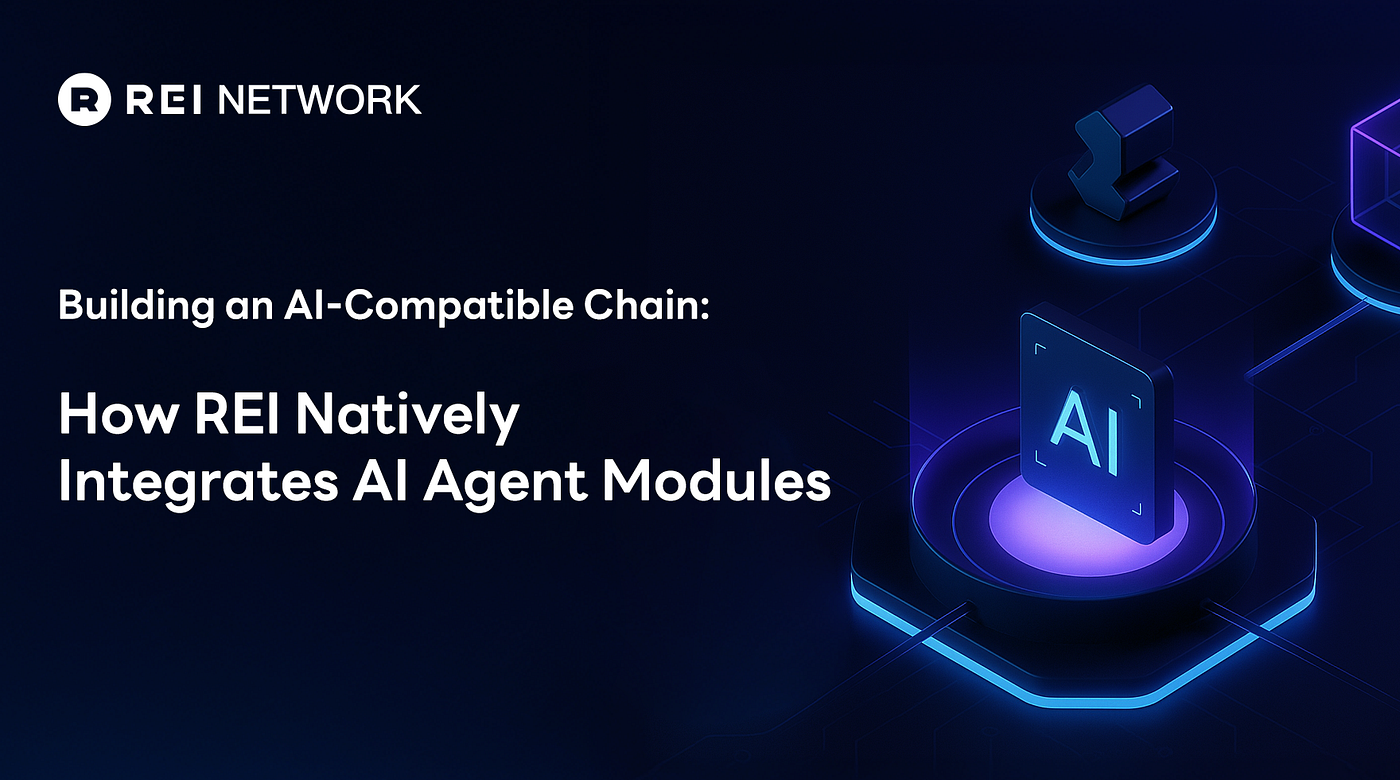
In 2025, the “AI Agent + Blockchain” combo has surged to the forefront of Web3 narratives. From Virtual to Cookie Fun, more and more projects are embedding decentralized agents into their chains to explore on‑chain autonomy, collaboration, and value exchange. But when AI Agents demand high‑frequency interaction, ultra‑low‑cost calls, and complex task coordination, the performance limits and architectural gaps of traditional blockchains quickly become apparent.
REI Network — a lightweight, EVM‑compatible chain renowned for its blistering speed — is tackling this head‑on with its proprietary MCP (Modular Computing Protocol). By building an on‑chain infrastructure that’s natively AI‑agent‑friendly, REI lays the groundwork, incentives, and ecosystem for truly “AI‑Compatible” applications. In this article, we’ll unpack how REI achieves that across four key dimensions:
1. Where AI Meets Blockchain: The Rise of the Agent Paradigm
An AI Agent isn’t just a prediction engine — it’s a goal‑driven, context‑aware, autonomous “digital worker” on chain. Unlike a standard model that passively returns inferences, an Agent can execute multi‑step workflows, coordinate with peers, and even evolve itself via on‑chain incentives.
Core values unlocked by Agents on chain:
- Identity & Reputation: On‑chain IDs, reputation scores, and execution logs resolve accountability challenges.
- Task & Reward Protocols: Blockchains excel at multi‑party task distribution and settlement, powering Agents with sustainable motivation.
- Composable Modules: Smart contracts can mix and match Agent capabilities, breaking down complex workflows into discrete, on‑chain actions.
- Data Sovereignty & Auditability: Transparent, verifiable records underpin data ownership and inference‑call provenance.
Since 2024, a wave of AI‑agent infrastructure projects has emerged — focusing on off‑chain model execution with on‑chain proofs, incentivized training networks, and NFT‑oriented AI assistants. Yet most still lean on external networks or Layer 2s, making the underlying chain Agent‑unfriendly: low throughput, high gas, poor modularity. MCP aims to shatter those barriers.
2. The MCP Advantage: A Native Execution Layer for Agents
MCP (Modular Computing Protocol) is a three‑layer framework designed to deliver modular, low‑cost, high‑frequency compute that feels native on chain:
- MCP Container (Execution Layer): Off‑chain container nodes run Agent code (Python, JavaScript, etc.) in lightweight sandboxes, syncing state with on‑chain contracts. To smart contracts, calling an Agent’s logic feels as simple as invoking an oracle.
- MCP Protocol Layer (Verification & Messaging): Agent results are fed back on chain with zk‑proofs or via Trusted Execution Environments, ensuring low latency and cryptographic certainty. Every outcome carries a proof that DApps can trust.
- MCP Modules (Component Marketplace): Agents register as modules — “Auto‑Research,” “On‑Chain Trading Assistant,” “Identity Proxy,” “Recommendation Engine,” and so on — in the MCP Registry. Developers upload, open up call permissions, and create a true “component market” for Agents.
With this design, REI becomes one of the very few EVM chains that can natively host Agent modules right on‑chain.
3. Agent Onboarding & Incentives: Co‑building the Ecosystem
To jump‑start module development, REI is rolling out an Agent Builder Program focused on three pillars:
- Open SDK & Templates: Developers get an SDK that bundles state‑sync APIs, MCP registration flows, and call standards — so spinning up an Agent takes minutes, not weeks.
- MCP Node Rewards: Hosting Agent modules earns you REI token rewards, weighted by call volume, module complexity, and uptime — think Bittensor, but optimized for DApp use cases.
- Module Marketplace: Developers can list modules as subscriptions, one‑off calls, or licensed packages in the MCP Marketplace. Revenue is auto‑distributed by smart contract, ushering in a “Module‑as‑a‑Service” (MaaS) economy.
- Ecosystem Grants & Incubators: In collaboration with AI‑infra and Web3 tool projects, REI funds high‑quality Agent initiatives — on‑chain data aggregators, cross‑chain risk monitors, automated gaming NPCs, and more.
4. MCP Marketplace: The New Infrastructure for AI Modules
The MCP Marketplace will function like an npm or HuggingFace for on‑chain Agents, featuring:
- Registration & Access Control: Developers upload modules, define interfaces, set usage fees and rate limits, and control who can call them.
- Composable Workflows: A drag‑and‑drop UI lets users chain modules into custom pipelines — e.g., “On‑chain Price Aggregator → Trade Decision → Contract Execution → Risk Monitor.”
- Ratings & Reputation: Modules carry on‑chain performance metrics — success rates, response times, historical logs — so users see transparent, dynamic scores.
What’s Next: From “Faster EVM” to “Smart‑Service Chain”
As AI Agents become Web3’s new “digital citizens,” blockchains must evolve from mere ledgers into full‑blown smart‑service platforms. With MCP, REI isn’t just delivering speed and low cost — it’s furnishing the complete toolkit for Agent deployment, composition, invocation, and monetization. This AI‑Compatible paradigm could well be the next chapter in Web3 infrastructure evolution, following the “Modular Rollup” wave.
Soon, every user will be able to spin up, combine, and deploy their own on‑chain Agents — and that’s when we’ll truly step into a “Society of On‑Chain Intelligences.”